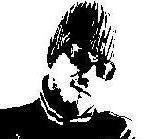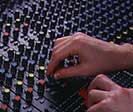| Author
|
Studio Monitor Speaker Placment.
|
in-human

Started Topics :
4
Posts :
28
Posted : Oct 3, 2006 09:02
|
I have noticed that many Psy Producers that have posted photos of their studios on the internet , seem to have their studio monitors set either side of their screens. I'm guessing that in a lot of cases this is the only choice for their position.
I did some research and I few pros have mentioned that you should do your monitoring in an equilateral triangle, with at least 3 feet between each point. From my own experience I find that if I get too close to my speakers I start to lose my low end perceivment.
I’d like to hear some other opinions on this.
Thx.
|

|
|
l337
IsraTrance Full Member

Started Topics :
55
Posts :
817
Posted : Oct 3, 2006 16:05
|
The monitors have been designed to be used in the equilateral triangle configuration with the tweeters in line with your ears....
They are so-called Near-field monitors , in that their radiation field is optium in the equilateral config....
so this would be the correct cnfig for your monitors
what monitors do you have?
generally the low end perceivment is worst when you are out of the field of your monitors..... from my expierence, however bass is so-called omni-directional (there are those who say this is not exactly the case, but lets not get into this)...
how low do you mean? 50 - 100 Hz....lower??
best advice i can give though is keep your monitors away from room corners and walls...to stop bass reinforcement,and or stick bass traps behind your monitors and in wall corners
but best of all...know your monitors...and know how the music you make on your monitors sounds on various other systems... |

|
|
Alex - Aural Invasion
Aural Invasion

Started Topics :
37
Posts :
514
Posted : Oct 3, 2006 17:05
|
Quote:
|
On 2006-10-03 16:05, l337 wrote:
The monitors have been designed to be used in the equilateral triangle configuration with the tweeters in line with your ears....
|
|
also, i read in my manual that the basscone should also be in height with tweeters, so laying down the monitors so they both are in line will give best setup i think.
        myspace.com/auralinvasion myspace.com/auralinvasion
reverbnation.com/auralinvasion
www.aural-invasion.com |

|
|
TOPE

Started Topics :
6
Posts :
185
Posted : Oct 3, 2006 20:14
|
Quote:
|
On 2006-10-03 16:05, l337 wrote:
The monitors have been designed to be used in the equilateral triangle configuration with the tweeters in line with your ears....
They are so-called Near-field monitors , in that their radiation field is optium in the equilateral config....
so this would be the correct cnfig for your monitors
...
|
|
That's the normal and simple aproach in setting the speakers within a room, but ultimately it depends how serious you are about accoustics...
An interesting way can be found in the book of Michael Stavrou "mixing with your mind" where he basically sugests to start with an empty room and DO NOT place the equipment where it loocks nice...use your ears!
Try to find the best place in the room where the bass is consistent with the high end, keep it mono when you are making the test and remenber if the speaker are to close from each other the phantom image between gets an increase of energy, when the sounds panned to the centre tends to appear louder, if you put them too apart the sounds panned to the centre are too weak and no presence, when you get them right a strong stero image will be there no matter where the sound is panned......as the guy said if in the end you finish with an equilateral triangle you should congaratulate yourself ,but remenber
this triangle stuff usually works in rooms with perfect accoustics not in the real world enviroment!
|

|
|
in-human

Started Topics :
4
Posts :
28
Posted : Oct 4, 2006 02:11
|
Some good advice above …..Thx.
I’m using Mackie HR824’s in a 4 Foot ( 1300mm ) equilateral triangle in the center of the room, with at least 1.5 feet ( 500mm) space between the Mackie’s and the back wall.
Mackie make a point in the manual not to lay the monitors down on their sides….. .
But if someone can convince me otherwise I’m open to change.
I’m thinking of getting the Mackie HRS120 Sub for more accurate perceivment,
has anyone had experience using one before?
I’m not sure about how low the freq range is, that is drastically changing when I’m move from
the triangle……. I have to do some experimenting when I get a chance.
Also I’m looking into building a bass trap.
Has anyone else had a go at building Broadband Absorbers?
Is it worth the trouble or just to bite the bullet and spend the bucks
and buy some acoustic foam?
My lecturer at S.A.E. is saying that the foam doesn’t do as good a job at absorbing
the low stuff as does the Rock wool.
Some links on “Do It Yourself” Broadband Absorbers below.
http://www.pmerecords.com/Broadband.cfm
http://www.samplecraze.com/tutorial.php?xTutorialID=28
http://arts.ucsc.edu/EMS/Music/tech_background/TE-14/teces_14.html
|

|
|
Alex Roudos
IsraTrance Junior Member

Started Topics :
33
Posts :
411
Posted : Oct 4, 2006 08:26
|
@ in-human
I wouldn't suggest at all that you buy the HRS-120. Besides that it is very expensive you don't really need it. The best thing about the 824's is their bass extension/response. And you have all the bass you need. Getting the HRS-120 you'll have nothing but bass unless you have a very big room and place it somewhere far from your mixing position.
Also what settings you have on the back side of your Mackies's? They should be at Half space and also you should switch the Low cut freq to 47hz, considering the distance from you and each other. Then try to mix down something and try it in other sound systems to check how it sounds. And don't place them on the side, they are not meant for that. Even the HR-626 that were designed to be also placed on the sides, they sound really bad when placed this way. Mackie's are designed to perform only in the vertical position.
I have the HR-624's, they go down only to 49hz but i feel i have all the bass of the world in my average sized room. For that i beleive it's only a matter of tweaking the settings in the back of your Mackie's and nothing else.
        A friend told me once that the biggest mistake we make is that we believe we live, when in reality we are sleeping in the waiting room of life. A friend told me once that the biggest mistake we make is that we believe we live, when in reality we are sleeping in the waiting room of life. |

|
|
in-human

Started Topics :
4
Posts :
28
Posted : Oct 5, 2006 02:39
|
Thanks Roudos for the info…….. Looks like you probably just saved me $3500.
At the present moment I have my monitors away from both the side and back walls , so I have all the HR824 settings to default.
But I will try the settings you recommended. Thx
Are your Mackies against any walls?
Have you also treated you room?
|

|
|
Alex Roudos
IsraTrance Junior Member

Started Topics :
33
Posts :
411
Posted : Oct 5, 2006 08:37
|
Glad to help mate....You mentioned earlier that your Mackie's stand 50cm from the back walls and 1.30m from each other in an equilateral triangle.
First of all, any speaker is considered away from the back wall when it is 1 meter or more away from it. So in that case you have to switch to half space the acoustic room setting. If you can get them in that distance then this would be the ideal.
Secondly, the distance between the 2 speakers themselves....i think they are too close and you just loose one of the best characteristics of the Mackie's. Their wide HOT SPOT. I have my 624's in a distance of 2m from each other, the stereo image i get is amazing and the bass kicks me in the chest. And my room is not treated at all.
So, to conclude i'd suggest to you the following :
1) Open up the triangle and let your speakers breathe and perform. 2 meters at least from each other.
2) If you can, put them 1 meter away from the back wall. If this is possible, the setting must be Whole space, otherwise half space.
3) After you do these, listen to something in quite high volume, with you sitting exactly in the center of the two speakers. In this case the triangle will not be equilateral but it doesn't really matter.
4) Set the low cut in the 37hz, so you get the full bass response of your Mackie's. I think, if you do these, then you are gonna feel and wonder "where is the sub?" and then definately you saved yourself $3500.
Just remember one thing : the only thing that the 824's don't need is a sub.
Let me know what happened if you try my suggestions.....cheers,
        A friend told me once that the biggest mistake we make is that we believe we live, when in reality we are sleeping in the waiting room of life. A friend told me once that the biggest mistake we make is that we believe we live, when in reality we are sleeping in the waiting room of life. |

|
|
UnderTow

Started Topics :
9
Posts :
1448
Posted : Oct 5, 2006 17:25
|
Quote:
|
On 2006-10-03 17:05, Alex - Aural Invasion wrote:
also, i read in my manual that the basscone should also be in height with tweeters, so laying down the monitors so they both are in line will give best setup i think.
|
|
Some monitors are designed to be place verticaly, some are designed to be placed horizontaly, some can handle both positions. So check the manual for each model of monitors.
Or am I misunderstanding you?
UnderTow |

|
|
l337
IsraTrance Full Member

Started Topics :
55
Posts :
817
Posted : Oct 6, 2006 09:07
|
Quote:
|
On 2006-10-03 17:05, Alex - Aural Invasion wrote:
Quote:
|
On 2006-10-03 16:05, l337 wrote:
The monitors have been designed to be used in the equilateral triangle configuration with the tweeters in line with your ears....
|
|
As UnderTow said.... only for some monitors...if the manual doesnt recommend you do that, then dont, because it will be worse than before....
I think K+H, Yamaha's, maybe Behringers as far as i am aware can all be placed on their sides....
also, i read in my manual that the basscone should also be in height with tweeters, so laying down the monitors so they both are in line will give best setup i think.
|
|
|

|
|
l337
IsraTrance Full Member

Started Topics :
55
Posts :
817
Posted : Oct 6, 2006 09:19
|
Quote:
|
On 2006-10-04 02:11, in-human wrote:
Some good advice above …..Thx.
I’m using Mackie HR824’s in a 4 Foot ( 1300mm ) equilateral triangle in the center of the room, with at least 1.5 feet ( 500mm) space between the Mackie’s and the back wall.
Mackie make a point in the manual not to lay the monitors down on their sides….. .
But if someone can convince me otherwise I’m open to change.
I’m thinking of getting the Mackie HRS120 Sub for more accurate perceivment,
has anyone had experience using one before?
I’m not sure about how low the freq range is, that is drastically changing when I’m move from
the triangle……. I have to do some experimenting when I get a chance.
Also I’m looking into building a bass trap.
Has anyone else had a go at building Broadband Absorbers?
Is it worth the trouble or just to bite the bullet and spend the bucks
and buy some acoustic foam?
My lecturer at S.A.E. is saying that the foam doesn’t do as good a job at absorbing
the low stuff as does the Rock wool.
Some links on “Do It Yourself” Broadband Absorbers below.
http://www.pmerecords.com/Broadband.cfm
http://www.samplecraze.com/tutorial.php?xTutorialID=28
http://arts.ucsc.edu/EMS/Music/tech_background/TE-14/teces_14.html
|
|
Well i work for an acoustics consultancy, sooo...
First off you shuold check your room be claculating the room modes
f = c/2 * sqrt (p^2/w^2 + q^2/l^2 + r^2/h^2)
where c = speed of sound , p,q,r = modes and w,h,l = room dimensions
rate the best thing is if PM me, and give me your email addy i will send you an excel sheet, that all you have to fill in is your room dimensions
then you will know where standing waves are going to be a problem....i.e problem frequency....
more than likely i can tell you now its going to be from about 100 - 250 Hz or there about (not that whole range, but a couple of narrow bands within that range)
then it is best to make some panel absorbers
and possible some diffusors
the thing to remember about an absorber is this...
if the absorber is not thicker than a quarter wave length of the freq you are trying to get rid of....its pointless
for example, a 100 Hz wave is 3.44m long...you do the maths here...and you will realise you need a very thick piece of foam to do anything substantial
also as far as the material goes... rockwool is better than normal foam, because it is more porous, which allows for the mechanis, of absorption to occur... google search: absorption coefficient, and you should find some info on this and what material are best
as far as designs go, i dont have time at mo to look at your links, however there are plenty enough of them out there on the web
you can even make yourself shrouder (excuse my spelling) diffussor , with wood strip and a router...
anyways..this subject is indepth and i only have enough time to touch the surface, hope it helps and good luck...if you have any questions feel free to ask
cheers |

|
|
Get-a-fix
Getafix

Started Topics :
147
Posts :
1441
Posted : Oct 6, 2006 15:57
|
|
FluoSamsara (Oxygen)
IsraTrance Full Member

Started Topics :
84
Posts :
1164
Posted : Oct 6, 2006 22:20
|
Woahh I just made the bought of the century!  12 panels 50*100*10cm of made compressed rockwool with a layer of a kind of glass fiber around it! greatzzz did such a huge change in my room, now i clap hands and its really so much drier 12 panels 50*100*10cm of made compressed rockwool with a layer of a kind of glass fiber around it! greatzzz did such a huge change in my room, now i clap hands and its really so much drier  and all for 50 euris looll!! got it from a bank conference room wich was being re-designed!! and all for 50 euris looll!! got it from a bank conference room wich was being re-designed!! 
Of course for low freq absorbtion you need to have something with a lot of mass like i´m gonna put some panels agains the corners and fill the part behind with sand bags, that should help quite a lot.
Also like I337 said, it won´t do much on the low end, but you can also (if you have space) put some thick curtains (ideally velvet but very expensive) and 1/4 wavelenght from the walls, and that will also improve the absorbtion quite a lot....
Theres just so much into it...just read as much as you can...some people spend years studying it and still reamains such a complex thing...
Good luck, a good room makes ALL the diference!
I also use pro sutios at school (sae amsterdam) and its amazing how you can hear so well all the details in a properlly designed environment, things like noticing eq changes of 0.5 db quite clearlly wich at home i find pretty impossible atm...
boomz! |

|
|
Freeflow
IsraTrance Full Member

Started Topics :
60
Posts :
3709
Posted : Oct 6, 2006 22:29
|
Great info all 
cheers
im in the works for acoustic treatment..
|

|
|